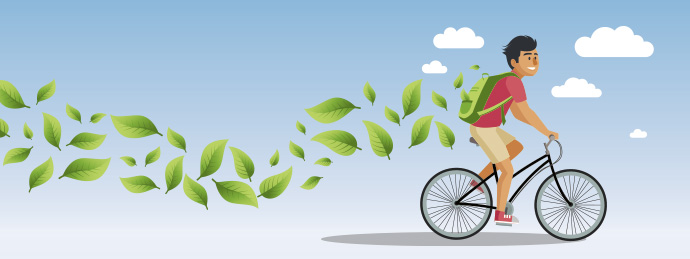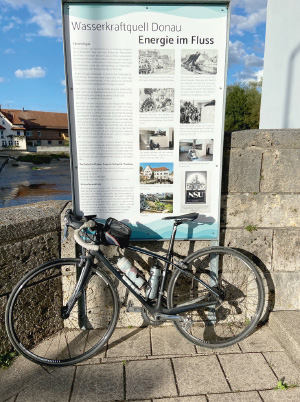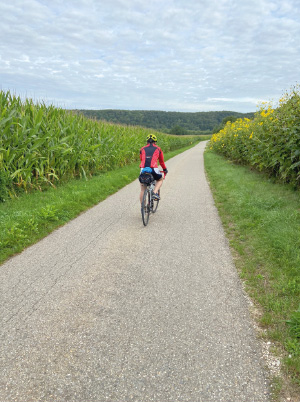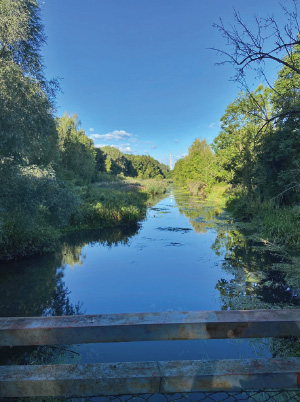Danube Watch 2/2020 - Climate Ride: Cycling 800 Kilometres Along the Danube to Raise Money for Climate Action
Climate Ride: Cycling 800 Kilometres Along the Danube to Raise Money for Climate Action
How to fundraise for Climate Change? Doing a “cycling challenge” seemed a great way of showing commitment, offering a great conversation starter, and doing it with a means – the bicycle – that we as a society still underutilise. The Climate Change crisis – in how it relates to our over-exhaustion of planetary resources so closely linked to the causes of the pandemic – won out as the core purpose for the ride.

ClimateRide.org organises these, but COVID had done away with the idea of participating in something that was organised by others. No big group gatherings anymore, whether in one room or along one ride.
The numbers reflect our ambition – “EightToOne”: the ride covered 800 km, riding for 7 Days, resting 6 Nights, writing 5 Blog Entries, on 4 Wheels (2 bicycles), using 3 means of transportation (in addition to 800km covered by bike, we used trains and boats); all of this bringing 2 generations together, along this 1 magnificent river.
Why the Danube? The Danube, while in good hands with the International Commission for the Protection of the River Danube (ICPDR), nonetheless faces huge climate related challenges – as documented by ICPDR through its Climate Change Adaptation Strategy:
www.icpdr.org/activities-projects/climate-change-adaptation


Sunday August 23:
From Donaueschingen to Rieslingen – 128km @ 21,6km/h, 7:15 hours
Stunningly beautiful is the only adjective that seems fitting to the Upper Danube valley, and no, I am not exaggerating. Cycling along the river, finding both agriculture and nature parks along the way, we were constantly stunned by yet more pieces of natural or man-made beauty.
Along today’s path, we saw pretty much everything that water resources management has to offer in terms of challenges: regulating stream flow, irrigation, water protection zones, various mills and others machinery generating electricity from water, two wastewater treatment plants (a nice new one and a stinky old one) and water used for recreation and ecological rejuvenation projects along parts of the Danube.

Monday August 24:
From Riedlingen to Dillingen – 127km @ 21.4km/h, 7:30 hours
I had not realised that there are places where the Danube looks like the Amazon – slowly moving, surrounded by what seems like the Swabian version of “jungle”. Waterlillies, spatterdock – in the Danube? Really? Well, the “nature paths” we cycled showed us the GREEN side of the Danube. All along the Danube here practically not a soul other than us, the occasional walker or hiker, an odd cyclist or two, but other than that – nature pure.

Tuesday, August 25:
From Dillingen to Ingolstadt, 100.14 km @ 21.4km/h

Donauwörth is what is called a “Sponge City” – having protected its old town from flooding through 6.5m high gates. By integrating water-permeable materials with a sponge-like structure and through smart planning of water areas, they allow the ground to absorb water. This does not just prevent floods; in warm temperatures, especially in summer, the ground emits water step by step and provides - in combination with the wind - a very comfortable micro-climate.

Wednesday, August 26:
From Ingolstadt to Regensburg and Passau, 85.6km @ 21.9 km/h, 3:53 hours
Today we cycled over bridges – bridges, bridges and bridges. The Danube features, not surprisingly, hundreds of bridges. From a cycling point of view, all this bridge business can be a bit of a nuisance, usually involving narrow and tight ups and downs and often not-easy-to-manoeuvre pavement. But there are upsides. As we criss-crossed the Danube and some of its little side-arms, we could stop and check out the fish. Fish love bridges, it seems, because of the shade they give and since they slow the river's current. Just looking down, we could see fish hopping about – many different ones, small and large. It turns out that the Danube river basin is home to numerous species such as pike, zander, huchen, catfish and many more!

Thursday, August 27:
From Passau to Linz, 89.2km @ 25.7 km/h, 5:45 hours

We had been warned about “hordes” of vacation-cyclists, crowding the bike paths along the Danube. But on the Northern Path – with a few exceptions, we had it pretty much for ourselves. Having said that, the path does not go “all the way” – there are two stretches along which there is literally no space for anyone to walk, cycle or drive made up of steep walls and vegetation. What to do? Another bridge? No: the ingenious Austrians have set up ferry-services to cater to both walkers and (mostly) cyclists. Neat little mini-barges that will take you along the Danube, for the five to ten minutes that you need to cover the few kilometres without a path…. for the steep fare of 4 Euros a pop.

Friday, August 28:
From Linz to Melk, 119.9 km @ 23.4 km/h, 6:10 hours
South of Linz, there is only one path along the Danube, the “Northern Cycle Path”; along the southern side of the river, there is no space – it is completely taken up by industrial harbour structures and by industrial plants. The biggest of them belongs to Voestalpine, Austria’s largest Steel producer and single largest CO2 emitter, accountable for about 10% of Austria’s total CO2 emissions. We cycled by a huge Voestalpine poster and reminded ourselves that steel and rivers belong together in some way; the rivers are needed to bring key resources, including coal for the smelting processes, to provide water for cooling and to transport steel plates further on, once produced. Voestalpine, as per their own declarations, is trying to look ahead, though: the European “Green Deal” will require them by 2050 to produce CO2 free.

Saturday, August 29:
From Melk to Vienna, 151 km @ 25.4 km/h, 7:48 hours travel time and 5:55 hours in the saddle….YES, we did it! 801 kilometres completed.

Today, we again came across the sign “Klimabuendnis”, put right underneath several town signs, visible to anyone crossing their boundaries. So this is interesting: the “Klimabuendnis” or “Climate Alliance” is an association of some 1,800 towns and municipalities across 26 European countries – and members joining the group commit to reducing CO2 emissions by 10% every 5 years, to implement measures in energy conservation, energy efficiency and in using renewable energy. Austria has a very activist outfit that woos many smaller villages and counties to join, explaining the strong uptake here.
Conclusion
As we cycled, we learned, and we talked about what we learned. ClimateRide.org – the organisation under whose auspices we organised the challenge – is all about “human powered activity”. And indeed, there is a certain magic to this. Quoting ClimateRide.org’s mission statement, I note that yes: We are all feeling concerned, anxious or overwhelmed by climate change. The threats to our world are numerous and growing more complex each day. While so many – in particular young people – care deeply and want to help address the problem, the enormity of the challenge and the political tone around climate change can feel dispiriting and disempowering. Our Danube Climate Ride offered us the chance to take on a challenge much bigger than ourselves – and to share our journey with our personal networks, helping to amplify support and reaffirming friendships and connections, all the while fundraising for climate change action.






